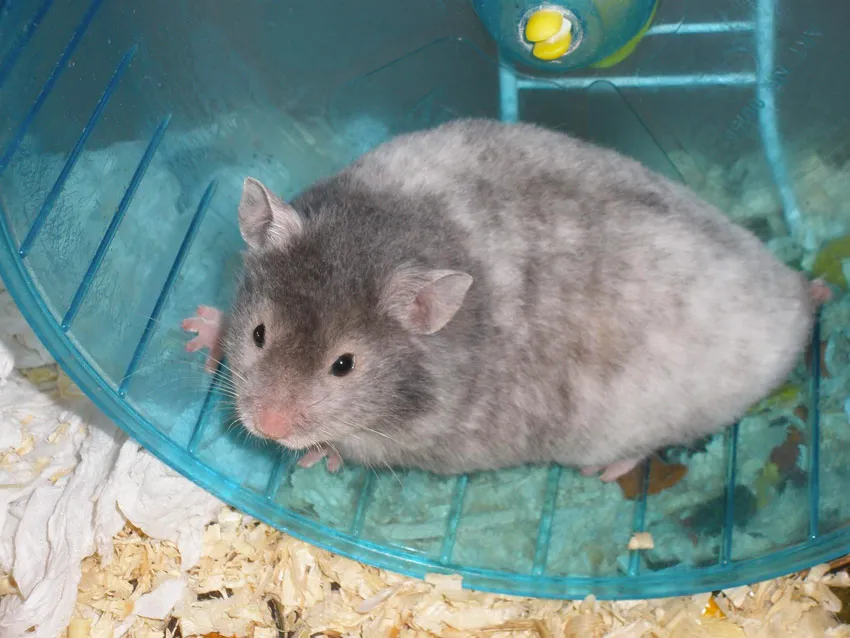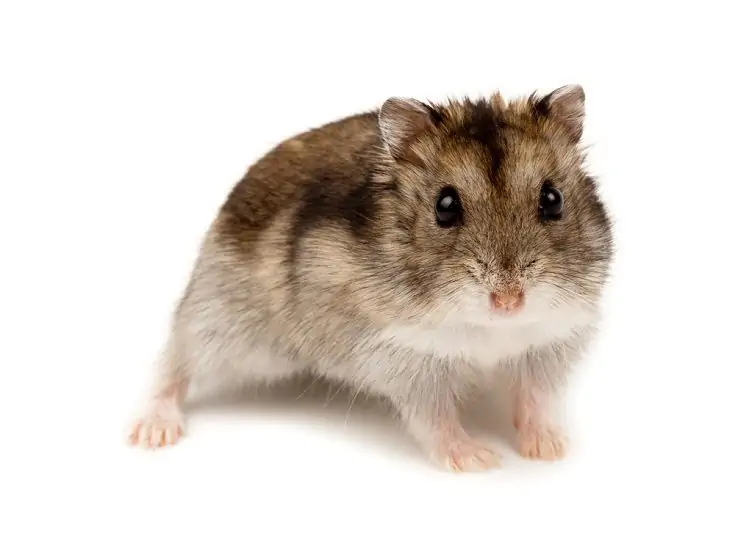Because of Oscar, there has been an uptick in interest in hamsters in our neighborhood.
Inadvertently he has swayed many children to ask their parents for a pet hamster because of his adorable, cuddly, and friendly demeanor Having previously assumed that all Syrian hamsters had golden fur, I’ve discovered that they actually come in a wide range of hues.
As their name suggests, wild Syrian hamsters were originally golden in color.
Although Syrian hamsters are now available in a wide variety of colors, patterns, and coat types thanks to better breeding procedures, they are still difficult to find.
5 Incredible Syrian Hamster Facts!
- Communicates aggression through teeth chattering.
- Travels as much as 8 miles in one evening to find and cache food.
- It Compensates for poor vision by using its scent glands to leave a trail, which helps it find its way home.
- A group of hamsters is called a horde.
- Can store up to one ton of food in a lifetime.
What does a Syrian hamster look like?
Syrian hamsters have short, stubby tails and sturdy, barrel-shaped bodies. Paper-thin ears contrast sharply with the little dark-glassed eyes of these nocturnal creatures.
There is nothing dainty about the tiny hands and feet of a Syrian hamster. But don’t be fooled by their innocent appearance; these hamsters are anything but that.
In general, Syrian hamsters are between 4 and 7 inches long, with females being slightly larger than their male counterparts.
It isn’t rare to see Syrian hamsters sold in pet stores under the names black bear or panda bear hamsters, despite the fact that Syrians are generally recognized as golden or teddy bears.
Syrian Hamster Scientific Name
The Syrian hamster, also called golden hamster, teddy bear hamster, standard hamster, or fancy hamster, belongs to the hamster subfamily Cricetinae, which contains 19 species divided into seven genera. Its scientific name is Mesocricetus auratus or Cricetus auratus. Mesocricetus is a genus of Old World hamsters that includes:
- Mesocricetus brandti: Turkish hamster or Brandt’s hamster
- Mesocricetus newtoni: Romanian hamster or Dobrudja hamster
- Mesocricetus raddei: Ciscaucasian hamster
Syrian Hamster Colors and Patterns
The Syrian hamster has the widest range of coat colors, textures, and patterns of all the hamster species.
There are more mutations in it because it has been bred for a long time. Among them:
1. Different coat types
Both satin and rex hair can be found on Syrian hamsters. Because of their soft coats, shorthaired Syrian hamsters are referred to regarded as “fancy” hamsters, whereas longhaired hamsters are referred to as “teddy bears.”
If not brushed on a regular basis, long-haired hamsters can develop matted fur.
The length of a man’s flowing skirt will differ depending on his testosterone levels (its long mane of fur).
Contrary to their male counterparts, the female long-haired hamster has a lower-cut coat with tufts behind the ears, on the hips, and on the back.
In comparison to rex hamsters, satin-coated hamsters have a glossy luster to their coats.
2. Different patterns

Your Syrian hamster’s fur can be decorated in a variety of ways. Tortoiseshell is one of the most common varieties.
Oscar’s coat is golden in hue and has a consistent pattern of fur. The color of his tubby belly appears to lighten slightly when you gently raise him.
There are several different types of Roans, but the most common are white hamsters with a splash of color running from their head to their tail.
While some are covered in a rainbow of hues, others are essentially the same. Their eyes will be reddish, and their ears will be speckled.
The most frequent design is the banded one, which features a white band around the middle of the hamster’s body. Bands vary greatly in their purity, with some showing signs of blemishing, others being absolutely clean.
It’s hard to miss the distinctive spots on the dominant spotted hamster’s white coat. However, it is not uncommon for the ears to have small spots on them as well as for there to be more color than white.
Female hamsters are the only ones who can have tortoiseshell fur that is speckled with yellow and white spots. As far as I know, they’re the rarest.
3. Different colors
The colors of hamsters are commonly referred to as agouti and self.
As you can see, the underbelly of an agouti hamster is lighter in color. Colors such as gold, brown, rust, cinnamon silver, and grey are common.
There are many different types of self-hamsters, but these are most popular in black, dark chocolate or cream, mink, or sable.
Syrian Hamster Appearance
Golden or golden-brown, as well as tortoiseshell, dominant spotted, and banded color patterns, are all possibilities.
Self-colored dogs have uniform, unbroken coats of various hues; dominant spotted dogs, on the other hand, have a white main body.
Golden dogs have a dark brown color that resembles a wild coat. There are two types of tortoiseshell: the more common banded, which has an even band of white along the middle, and the more uncommon tortoiseshell, which has bands in red and black with yellow spots on top.
Hamsters come in a variety of hues, patterns, and breeds. coat color can be any one of the following:
- Beige
- Black
- Blonde
- Brown
- Chocolate
- Cream
- Dove
- Golden
- Grey
- Lilac
- Mink
- Sable
- Tan
- White
They can have short, medium, or long hair; they can also have a rex or satin coat, and they don’t have any hair at all!
A single female hamster found in 1930 by Dr. Israel Aharoni and the first hamster discovered in Syria’s Aleppo region are the closest relatives of the short-haired hamsters in terms of appearance.
It is only the long-haired male hamsters, which can grow to a maximum of 4 inches (10 cm) in length, that are known as “teddy bears” or “Angora hamsters,” since their fur is much longer and more densely woven.
There are three types of hamsters: those with rex-haired hair, those with satin-haired hair, and those with hairless hair.
They range in size from 12.7-to 17.78 centimeters in adults. When purchased from private breeders, they can weigh as little as 100 grams (3.5 oz) to as much as 175 grams (6.2 oz) for each pup.
Unlike other members of its subfamily, the Syrian hamster possesses expanding cheek pouches that stretch from its cheeks to its shoulders.
Do male and female Syrian hamsters differ in color?
Females can only have tortoiseshell coats, although this does not always mean that they are the only ones with that hue.
As a result, the flank glands and private anatomy of a male and female hamster can help you tell them apart.
To guarantee that your pet hamster is correctly sexed, read our blog on how to tell the sex of your hamster.
Can Syrian hamster coats change color?
Syrian hamsters, like humans, change color as they become older, so there’s nothing to worry about.
If it doesn’t happen in a matter of days, or if your Syrian suddenly loses their hair or baldness, this isn’t a health concern.
Do Syrian hamsters have different eye colors?
It’s common for the color of a Syrian hamster’s eyes and ears to be influenced by their coat color.
Some coat colors, like the cream variety, can have a variety of eye and ear color combinations, such as black, red, or ruby eyes.
Syrian hamsters with red eyes are usually blonde, cinnamon or lilac-colored. Mink and copper have red eyes that darken as they get older, while certain hamsters have unusual eyes, or heterochromia, which is a condition that affects a small percentage of the population.
Because of the irritating eye’s pink tint, conjunctivitis in hamsters is also known as “pink eye.”
Syrian Hamster Behavior
Like other hamsters, Syrian hamsters show aggression by chattering their teeth. They can get used to the sound of a human voice and respond to it.
They are also easy to train. In the wild, they sleep through the winter. When they are kept as pets, they only sleep when the temperature drops below 8 degrees Celsius.
Syrian hamsters live alone and have their own territory. The only time they interact with other animals is during mating season.
They mark their home ranges with scent glands on their sides. This helps them find their way home since they can’t see very well.
Male hamsters are different from females because males lick their bodies near the flank glands to wet their fur and drag their sides along things to mark their territory.
Females, on the other hand, use both bodily fluids and feces to mark their territory.
People thought that Syrian hamsters only came out at night, but they actually come out at dawn and dusk. They stay in their burrows during the day and come out to look for food at dusk.
They make several trips between food sources and their burrow to find, carry, and store food while avoiding the extreme daytime and nighttime temperatures. They can go as far as 8 miles in one night to find and store food, but most days they only go 2–5 miles.
One hamster can store up to a tonne of food over the course of its life. They keep their food away from where they urinate and where they lay their eggs.
The only exception is very old, weak-toothed hamsters, which soak hard seeds and nuts in their urine to make them easier to eat. Syrian hamsters are great housekeepers because they clean up their rotting and moldy food.
In the wild, they bring food home in their cheek pouches, which they empty by pushing food out of their open mouths from back to front with their paws.
They sometimes put so much in their pouches that they can’t close their mouths.
A horde is a bunch of hamsters. The Syrian hamster is terrestrial, altricial, burrowing, browsing, fossorial, sedentary, cursorial, territorial, solitary, and polygynous during mating season.
Syrian Hamster Reproduction and Life Cycle
Male Syrian hamsters are polygynous, which means that one male can have babies with more than one female.
When the days are long, or when the photoperiod is long, animals can breed. Females can have babies every month and go into heat (estrus) every four days, even if they already have a litter. This can make the babies weak and hungry.
There are 8 to 12 babies in a litter, but sometimes there are 20. On average, 8 to 10 babies are born with their eyes closed. Mom takes care of them.
Some mothers may eat their own babies if they have a lot of babies, don’t know how to care for them, or feel threatened. This can also happen in the wild when there isn’t enough food.
They also eat their dead pups, and wild females may kill and eat their pups if they have been around people and smell like them.
The young hamsters, called pups, open their eyes at 12–13 days and stop eating their mother’s milk at 19–21 days. At one month, they are ready to reproduce.
Does are the name for adult female hamsters, and bucks are the name for adult males.
At about 16 days, golden hamsters and other hamsters in the genus Mesocricetus have the shortest gestation period of any placental animal known.
Even though pregnancy can last up to 21 days, it usually leads to problems.
The Syrian hamster lives for two to three years, with a typical life span of one to two and a half years and an average life span of 1.5 to two years. Syrian hamsters in cages act just like they do in the wild.
Conclusion
When it comes to buying a Syrian hamster, there is no one size that fits all.
Not only do they have different colors, coats, and eyes, but they also have different personalities.
Syrian hamsters used to be called the golden or teddy bear hamster, but their names are now changing to reflect the different breeds that have come about as a result of breeding.






